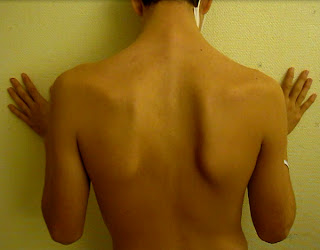The shoulder complex houses the most mobile joint in the human body allowing us the freedom to move and use our arms in a multitude of ways.
The shoulder complex is comprised of three joints:
sternoclavicular joint
(where the sternum (breastbone) and
clavicle (collarbone) meet)
·
Connects arm & shoulder to the rest of the
skeleton
·
Saddle type joint that allows for movement of
the clavicle
·
Supported by a strong network of ligaments
acromian clavicular
joint (where the clavicle (collarbone) and scapula (shoulder blade) meet)
·
Allows us the ability to raise our arms overhead
·
Stabilized by a small network of ligaments
glenohumeral joint
(where the head of the humerus (upper arm
bone) meets with the glenoid fossa of the scapula (shoulder blade))
·
Most mobile joint in the body
·
Shallow ball & socket joint
·
Rotator cuff muscles help to hold the head of
the humerus in the glenoid fossa (supraspinatus, infraspinatus, subscapularis,
teres minor & major).

In addition to these three joints, there is also a scapulothoracic articulation. Although not a true joint, the articulation
between the posterior thoracic cage and the anterior surface of the scapula is
very important for the stability of the glenohumeral joint.
The coordinated movement of the glenohumeral joint and the
movement of the scapula on the posterior thoracic cage are called scapulohumeral rhythm.
To understand how all the muscles involved in scapulohumeral
rhythm work, let’s first look at the different ways in which the scapula can
move:
|
|
The muscles that support the scapula throughout this range
of motion include: serratus anterior, trapezius, rhomboids & levator
scapulae
Action
|
Muscle(s)
|
Elevation
|
upper trapezius, rhomboids & levator scapulae
|
Depression
|
lower trapezius, lower serratus anterior
|
Protraction (abduction)
|
serratus anterior
|
Retraction (adduction)
|
mid trapezius and rhomboids
|
Upward rotation
|
serratus anterior, upper & lower trapezius
|
Downward rotation
|
rhomboids & levator scapulae
|
SCAPULAR STABILIZERS
 |
| credit: www.bandhayoga.com (Dr. Ray Long & Chris McIvor) |
When all of the scapular stabilizers are working together in a synchronous way, the scapula and the arm bone will move together in a way that will keep the humerus securely seated in the glenoid fossa and will keep the scapula in even contact with the posterior thoracic cage.
When the scapular stabilizers are not working properly the
scapula and the humerus move in a dysrhythmic way. This scapular dysrhythmia can lead to pain,
weakness and impairment of shoulder mobility.
The rotator cuff muscles often wind up overworked or injured as a
result.
A physical sign that helps to indicate a problem with scapulohumeral rhythm is scapular winging. True scapular winging is due to complete loss of function of the serratus anterior muscle and is very rare. However, more subtle muscular imbalances, weaknesses or pain can also cause subtle scapular winging or scapula dyskinesis. Noticing this sign early and learning to retrain your scapular stabilizers to work together in a synchronous way can help to increase stability & mobility of the shoulder complex and prevent injuries down the line.
Here is what scapular winging looks like and some
suggestions for strengthening the scapular stabilizers to restore
scapulothoracic rhythm.
Looking at the big
picture: The shoulder is a very
complex joint. Alignment of the thoracic
spine, rib cage alignment, head carriage and neck alignment will all effect the
position of the scapula and therefore the mobility of the joint and the ability
of the scapular stabilizers to work in a synchronous way. Understand your starting point before you
begin any exercise routine.
- Do you tend to slouch or hunch your shoulders forward?
- Do you tend to jut your chin forward and carry your head forward of your chest?
- If you pull your shoulders down and in and open your chest does your ribcage thrust forward?
If you answered yes to any of these questions you may need
to begin by working on your thoracic spine alignment and mobility before being
able to properly improve your shoulder strength and mobility (more on that in future posts!)
Improving strength
& flexibility: remember that you
want to achieve a balance between mobility and stability in the shoulder
complex. Exercises that strengthen the
scapular stabilizers such as the “push up plus” must be coupled with exercises to stretch the chest muscles and anterior shoulder.
Improving motor
control: exercises that use
resistance to lengthen muscles as they contract (eccentric contraction) can
help to improve motor control. Slowing
the pace of exercises like push ups or lat pulls and using internal resistance
throughout the full range of motion will help to make sure all the scapular
stabilizers are working together throughout the full range of motion.
Here is a great simple article about cueing scapular motion
during different exercises. I
particularly appreciate the mention of ribcage and neck alignment: http://www.acefitness.org/certifiednewsarticle/2384/correct-cues-for-scapular-motion/
There is so much to think about when it comes to proper shoulder alignment. Remembering to focus on alignment & stability first coupled by a balance between strength and flexibility will help you find your rhythm and keep you injury free for years to come!
References:
http://www.jaaos.org/content/11/2/142/F1.expansion
http://www.pt.ntu.edu.tw/hmchai/Kinesiology/KINupper/Shoulder.files/ShoulderStructure.htm





